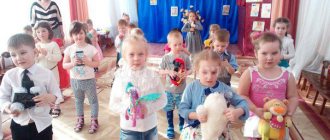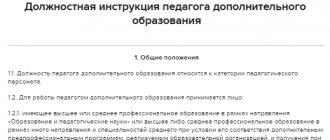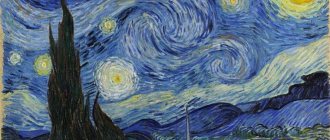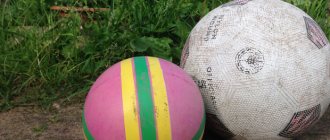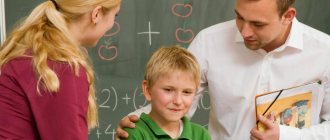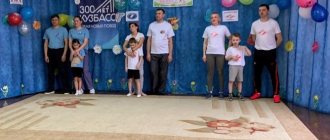Long-term plan for working with parents of the senior group
Elena Lotakova
Long-term plan for working with parents of the senior group
September:
Form of work . — Parents' corner : presentation of information about the objectives of the program and the intellectual characteristics of children 5 years old;
design for the holiday “Knowledge Day”
;
moving folder “Autumn”
;
folder – movement “Rules of conduct in transport”
;
production of attributes for the role-playing game "Family".
— Parents’ meeting “A good family will add intelligence”
mind."
— Adaptation activities for children returning from summer vacation.
— Consultations “For you, parents !”
,
"Mom, don't go"
.
— Questionnaire “Is your child attentive?”
.
— Exhibition of crafts “Gifts of Autumn”
.
Individual work . — Individual conversations on the development of a child’s memory through counting rhymes, poems, riddles.
— Consultation “How to properly dress a child in the fall”
.
— Conversation “Child’s appearance and instilling cultural and hygienic skills”
.
October:
Form of work . — Holiday “Golden Autumn has come to visit us”
.
— Exhibition “The Unusual is in the Ordinary.
— Consultations “Why does a child need to draw?”
,
“Why doesn’t the child want to eat?”
— Excursion to the museum named after. Grodekova “Fauna of the Far East”
— Parent’s corner : folder – moving “Age characteristics
children of senior preschool age";
folder – movement “Games for health”
.
Individual work . — Daily conversations with parents about children’s behavior when communicating with each other.
— Conversation “Joint work of a child and an adult”
.
— Conversations with parents “About the need for vaccination against
influenza and ARVI"
November:
Form of work . — Conversation “How to spend a day off with a child?”
— Consultations “The role of grandparents in family education”
,
“The authority of parents and its influence on the development of the child’s personality.”
— Exit to the Youth Theater.
— Questionnaire “What kind of parent ?”
— Competition “Look, bagels, piping hot rolls, hot from the oven...”
(dedicated to Mother’s Day)
— Parent’s corner : folder - moving “Developing fine motor skills of the hands”
,
folder – movement “Prevention of acute respiratory infections, hardening of children”
.
— Entertainment “Autumn - Name Day”
.
Individual work . — Individual conversations with parents “Sportswear and shoes for physical education”
, about the need to purchase it.
— Consultation “Main directions in the development of speech of older
preschool age."
December:
Form of work . — Decoration of the group and music hall for the New Year's party.
— Creative workshop: sewing costumes for children for the New Year.
— Memo for parents “How to answer children’s questions”
.
— Consultation “Flu. Prevention measures. Symptoms of this disease"
.
— Parent meeting “Games and toys in the life of a preschooler”
.
- New Year's celebration.
— Competition “New Year’s toys”
.
— Parent’s corner : folder – moving “Winter”
.
— Carrying out a campaign for parents and children “Help the birds in winter”
.
— Literature exhibition “Game and Children”
.
— Excursion to the library.
— Consultations “What a children’s toy will tell you about”
,
“I clean up the toys myself”
.
Individual work . Conversation “Game spies are one of the measures to prevent viral infections”
January:
Form of work . — Photo exhibition “How we rested in winter”
.
— Involve parents in the construction of snow and ice structures on the site.
— Conversation “Home reading for the heart and mind”
.
— Excursion to the children's environmental center.
— Consultations “Hyperactive child”
,
“You or You?”
— Parent’s corner : folder – moving “When it’s snowing outside”
.
Individual work . — Daily conversations with parents about the behavior and communication of children in the group with each other .
— Individual. consultations “How to take a winter walk with your child”
pleasant and useful?
— Individual conversations “Hardening is one of the forms of prevention
colds in children."
February:
Form of work . — Thematic exhibition “Drawing with Dads”
.
— Sports festival “Defender of the Fatherland Day”
.
— Design of the wall newspaper “February 23”
.
— Excursion “Defenders of the Fatherland in Ancient Russia”
museum named after Grodekova
— Consultation “30 tips for raising sons”
,
"Little Manipulator"
.
— Exhibition of children's drawings “My Dad”
.
— "Birthday Day"
.
Individual work . — Individual. Conversations with dads “Who do you consider most important in raising a child?”
— Conversation “Fundamentals of moral relations in the family”
.
March:
Form of work . — Parent’s corner : folder – moving “Spring is Red”
.
— Photo exhibition “Me and my mother!”
— Design of the wall newspaper “The Best.”
- Holiday of Spring and mothers.
— Creative works of children for March 8 “Mom is my sunshine”
.
— Consultations “Nature and moral education of older ”, “Why is it necessary to develop children’s interest in nature”
— Involve parents in decorating a vegetable garden on the window.
— Memo for parents “Safe steps towards road safety”
.
— Thematic exhibition “Attention Street!”
— Excursion to the Zoo named after. In Sysoeva
Individual work . — Conversations with parents about changing clothes with the arrival of warm days (do not bundle up children, be sure to have a change of clothes)
.
— Consultation “The ABCs of Traffic”
.
— Individual consultations “Child and the road”
: rules
behavior on the city streets."
April:
Form of work . — Parents’ meeting “Television in the life of a family and a child”
.
— Parent’s corner : folder – moving “Cosmonautics Day”
,
"Advice from a speech therapist"
— Invite parents to participate in the cleanup.
— Consultations “On nurturing a positive attitude towards work in preschoolers”
,
"Human and nature"
.
— Conversation “Children’s drawing is the key to the child’s inner world”
.
— Museum "Fish of the Amur"
— Involve parents in making flags.
Individual work . — Individual consultations “Art activities at home”
.
— Conversations “How to protect a child from injury”
.
May:
Form of work . — Memo for parents “Visual activities of preschoolers”
.
— Questioning parents “How do you evaluate the work of kindergarten employees ?
— Consultations “Learning to Tell”
,
"Memorable places of our city"
,
“Development of thinking in preschool children”
.
— Conversations on exciting topics for parents .
— Round table: diagnostic results.
— Competition “Best Flowerbed”
.
— Labor landing: parents’ in landscaping and landscaping of the site.
— Photo exhibition “Favorite places of Khabarovsk”
.
- “We are glad to congratulate you...”
(birthday day)
.
— Exit to the Drama Theater or Youth Theater.
Individual work . — Conversations of the senior group should know and be able to do ”
.
— Conversations “Organizing summer holidays for children”
.
Consultation for parents of older preschoolers on the topic: Spring
Consultation for parents of the kindergarten “Beautiful is nearby!”
Author: Zimenko Tamara Aleksandrovna, teacher of MBDOU “Cherlaksky kindergarten No. 2”, Omsk region, r.p. Cherlak. Description of work: This material will be useful to teachers of preschool educational institutions and parents of children of senior preschool age. The consultation can be used as information board material for parents, as well as to organize a subgroup consultation for parents. Goal: enriching parents’ knowledge about the features of the development of observation and curiosity in children of senior preschool age.
Living in the modern world, when everyone has a lot of things to do and problems, we sometimes do not notice what is happening around us. But our life is full of wonderful moments. We need to learn to notice the beauty around us and teach our children this! After all, a person who does not know how to notice the beauty around him, like a fish without water, cannot live a full life! The Goddess, Nature, can help us with this. The heart of each of us wakes up and rejoices with the awakening of nature after a long and cold winter. And we must share this joy with our children. It is parents who will be the first “teachers” and will help discover the beauty of the natural world to their children. There is no need to rush, you need to find a few minutes to draw the preschooler’s attention to the beauty around us. The onset of spring is the best time to observe with children. Walking with your child in the fresh air can be a very useful and interesting activity. The child will develop knowledge about nature and respect for it. While walking with your child, pay attention to the following points: - sun - the sun rises higher, shines brighter, its rays warm more. Invite your child to play with the “sunny bunnies” and try to catch up with them. Read the poem: “Under the Sun” by G. Dyudin It’s a miracle to live under the sun! To man, beast, bird - the Sun is given to all its pets one particle at a time. An ant, a sperm whale and a flower in a pot with a tray are given maternal care by the gentle sun. He bakes Easter cakes in the sand with the kids in the hot summer and sprinkles them all over his cheeks with freckles. Now he plays blind man's buff with us, now he wants to hug us with rays, now he playfully tickles our noses, like a straw. Living under the sun is a miracle! Under his radiant gaze. It's far away from here, but it always seems to be nearby. The sun is the light in the window and in the wide open door. It is impossible to live without the sun, just like without a heart! - snow melting - the amount of snow decreases every day. You can check this with a ruler or stick by placing them in the snow. It will be noticeable how the amount of snow decreases by the divisions on the ruler or stick. Every day the color of the snow becomes darker, from white and fluffy it has turned into gray and dirty. Read the poem: N. Antipina Where did the snow go? Recently He was the most, most important thing here: He lay on the roofs, on the paths And stuck to my boots, He hung on the branches of poplars, He melted in people’s palms, He hid the forest under the white fluff, And recently he disappeared. We walk along the wet streets, Water, water, water all around. - icicles - when snow melts and water rolls off roofs, icicles are formed; due to changes in air temperature, the water either melts or freezes, due to which the icicle increases in size. Remind children that icicles falling from roofs are dangerous. Read the poem: Ya. Yakovleva The sun is warming up hotter, The snow is already melting on the roof, Five icicles began to cry, Two melted and fell. - streams - when the air temperature rises, intensive snow melting occurs; the ground has not yet thawed and cannot absorb moisture, so the water seeks its way and, forming streams, rolls down into the lowlands. Invite your child to launch the boat and watch it and the speed of the stream. Read the poem: “A trickle” by K. Balmont A trickle, a trickle, a trickle, You go like a thread. The sand glitters beneath you. You are cheerful, even if you are shallow. Little stream, little stream, You go away and sing. Bees hover between the stems, A furry bumblebee buzzes. You run faster, faster. Suddenly, captivity among the stones - Foaming louder, more cheerfully, You will murmur: “Stranded, stranded, stranded!” You are not wide, little stream, You are not deep, so what! Little stream, little stream, You run and you sing! - birds - draw the child’s attention to the fact that both wintering and migratory birds chirp cheerfully, pleasing our ears. Consider what the birds look like, how they differ from each other in size, shape of beak, and legs. Listen to the singing of birds with your child and offer to count them. Read the poem: Vitaly Gasnikov A bird sat on the window - So it’s already light there! Birds sing in the morning - They give the joy of beauty! In the summer I went out in the morning - not for cars, but for the birds of Ra! The sun is shining, the sky is golden, and birds are trilling from the trees! The bird is like a friend, comrade, brother. Everyone is happy about it in their soul! - trees - roots intensively draw in moisture, trees buds swell and leaves appear, which produce the oxygen we breathe. Trees are the “lungs” of planet Earth. Read the poem: E. Grudanov How warm! There is a feast in nature! The buds have opened, and sticky leaves look out at the world. — the first flowers are dandelions, mother and stepmother, snowdrops. Flowers delight us with their beauty and variety of aroma. Bees collect pollen from them. And people have their own secret - using plants as medicine. Read the poem: “First Flowers” Mischievous Little Fox The days have become longer and brighter, The slanting winter is fading into the shadows. The snowdrifts are melting. The living Earth is crawling out from under them. She breathed in the sun and has already sprouted the first blades of grass. And so, like a yellow jelly bean, Flowers scattered along the path. I will stroke these first flowers with a wet hand... I was waiting for the birth of beauty And I imagined it like this: Breaking through the snow and ice, Breaking the witch's spell, Sprouts of quiet beauty Warm people's hearts!.. - insects - ants, butterflies, mosquitoes, beetles awaken and begin to be active life. Remind children that bites from insects such as ticks can be life-threatening. Read the poem: “Merry Ball” Galina Galina In the meadow a merry ball was opened in the spring: The mosquito played on the trumpet, the shaggy bumblebee danced with the blue fly. And the breeze swirled, playing with the leaves. And the flower swayed to the beat, bending its green stem slenderly. The dragonfly rushed easily. Watching nature is a very interesting and educational activity. During these observations, children develop qualities such as intelligence, observation, the ability to compare and draw conclusions. Thanks to such communication, children will learn to notice the beauty in the world around them! Good luck to you, dear parents, in the development and upbringing of your children!
We recommend watching:
Consultation for parents of a preschool educational institution Consultation for parents of a kindergarten Traditional forms of working with parents in kindergarten Consultation for parents of the senior group of a preschool educational institution. Parental authority
Similar articles:
Consultation for parents of kindergarten “Going to the store with a child”
Consultation for parents. Traveling with a child in summer
Consultation for parents “Bicycle and child”
Types of family education and their characteristics
The influence of parents on the formation of a child's personality
Outline of the parent meeting in the senior group topic: “Speech development of the child”
Parent meeting outline
in the senior group "Fidgets"
topic:
“Child’s speech development”
Topic:
"Child's speech development"
Target:
— Creating conditions for the speech development of preschool children in the family;
— Improving the pedagogical culture of parents.
Tasks:
— Introduce parents to different types of games and game tasks for the development of children’s speech;
— To promote the acquisition of practical skills in their use at home.
Forms of implementation: Workshop using game training.
Participants: Teacher, parents.
Equipment for the event: felt-tip pens, recording of calm music, handkerchiefs (according to the number of participants), ball, ball of thread.
Event plan:
- Introductory part.
- Game training “Developing a child’s speech.”
- Final part.
- Miscellaneous
Preparatory work:
- Making invitations to meetings for parents;
- Prepare proverbs about language
- Organize an exhibition of literature on children's speech development.
- Prepare instructions for parents “Little tricks”, “How to read to children”.
Progress of the event.
- Introductory part.
Teacher: good evening, dear parents! We are very glad to see you at our meeting dedicated to the problem of speech development in preschoolers.
Games help both children and adults feel comfortable and confident and relieve anxiety. To do this, I suggest you play the game “Compliment”. Now we will pass the ball around in a circle. When you pick it up, you will need to introduce yourself: say your name and patronymic and, handing it to your neighbor, tell him a compliment.
The teacher plays the game “Compliment”. Purpose of the game: to establish contact between parents, to form a positive attitude in them.
What do you think speech is?
Speech is a powerful tool for the comprehensive development of a child. The skill of correct speech, like all good skills, is acquired in the family. What a family does to develop a preschooler’s speech is of great importance for his entire subsequent life.
Main goals and objectives
in the program that is used in our kindergarten.
Speech development.
Developing free communication with adults and children, mastering constructive ways and means of interaction with others.
Development of all components of children's oral speech: grammatical structure of speech, coherent speech - dialogic and monologue forms; formation of a dictionary, education of the sound culture of speech.
Practical mastery of speech norms by pupils.
Fiction.
Cultivating interest and love for reading; development of literary speech.
Cultivating the desire and ability to listen to works of art and follow the development of the action.
If we consider children as a whole, then of course everyone has problems with speech development. Children who especially need specialized help take classes with a speech therapist. You can all freely approach teachers for help.
Free, clear, logical, expressive, beautiful oral speech of a child is a goal to which we should strive. Achieving this goal is not easy, and we are concerned that the number of older preschool children with defects in the pronunciation of speech sounds and other qualities, with poorly developed coherent speech, and monotonous speech is growing.
What speech development games can you organize with your child if you are busy in the kitchen while cleaning the apartment?
What can a child do while waiting for an appointment with a doctor, at a hairdresser, etc.?
The problem of speech development in preschool children is acute today. We can only solve it through the cooperation of the family and the kindergarten. I want to offer you a number of ways and techniques that can help solve this problem. Today you will learn why you need to do finger exercises and what word games you can play with your child at home.
2. Game training with parents.
Educator: Dear parents! You are probably well aware of the famous statement by V. A Sukhomlinsky “The mind of a child is at the tips of his fingers.” Scientists have come to the conclusion that the speech and motor centers in the cerebral cortex are located nearby and partially compensate for each other’s functions. In addition, psychologists say that finger exercises develop attention and memory.
What finger games do you know?
I would like to introduce you to the finger gymnastics “Two Centipedes”,
which you can spend with your child at home. These are various movements of the fingers using poetry.
Let's all practice together.
Two centipedes were running along the path.
They ran and ran and met each other.
We met each other and hugged each other tightly.
They hugged each other so tightly that it was difficult to separate them.
Finger games based on poetry develop a sense of rhythm and help children work on their diction.
You can use finger games with objects. Let's play with handkerchiefs. The game is called "Swallow".
Take the handkerchief by the corner and try to gather it into your fist without helping yourself with your other hand. In this case, you can say the following words:
“I have a swallow,
He swallows everything,
So it became swallowed
The belly is like a hippopotamus.”
This game can be complicated: not only perform movements alternately with your right or left hand, but then with both hands at the same time.
As such items for finger games, you can use natural materials (acorns, chestnuts, nuts, etc.), any small toys, mosaics, construction parts, matches without sulfur, and much more. But the main condition is that it must be a game, then the child will be interested. For example, you can play “Cinderella” - separate the peas from the beans and beans, or sort out some cereal. During this game, safety rules must be observed, since small objects can only be played with in the presence of adults.
You can play “builders” - build houses from counting sticks or matches without sulfur. You can play “seamstress” - wind the threads into a ball or wind them on bobbins, you can lay out a picture according to the sample. You can come up with your own games - there is a lot of room for imagination.
Word games are especially effective for developing a child’s speech. They improve conversational speech, enrich vocabulary, and form the grammatical structure of the language. Develop attention, memory, intelligence.
Let's learn some word games that you can play with your child. So, let's begin!
The teacher conducts practical activities with parents to master the techniques of developing children’s coherent speech using exercises:
Exercise 1. Choose epithets and definitions for the word. For example: elephant - ... (big, gray, fat, kind); ball - ... (round, football, leather); cake - ... (sweet, fruity, chocolate, delicious), etc. (Parents' answers).
Exercise 2. Find out from the description. For example: clubfoot, loves honey and raspberries, sleeps in a den. Who is this? Bear; branchy, tall, green, prickly. What is this? Spruce; old, brick, two-story. What is this? House; menacing, big, with a shaggy mane. Who is this? A lion.
Exercise 3. “What if...” Invite them to dream: “And if I had a magic carpet...”, “And if I had walking boots...”, “And if I had a time machine...”, “And if I had a hat- invisible..."
Exercise 4. “Name it in your own way.” Give a new name to a poem, fairy tale, cartoon. For example: what can you call the fairy tale “Little Red Riding Hood”? (“Adventures of a little girl”, “On the way to grandma”, “How to tell a grandma from a wolf”, etc.).
Exercise 5. “Other characters.” Tell a fairy tale by changing the roles of the characters. For example, the Russian folk tale “The Three Bears”: the girl is evil, Mikhail Ivanovich; Nastasya Petrovna; Mishenka - kind.
Exercise 6. Come up with a continuation of the fairy tale. For example, what do you think happened after the fox ate Kolobok?
What articulation exercises do you know?
Articulation gymnastics
is a set of special exercises aimed at strengthening the muscles of the articulatory apparatus (speech organs), developing strength, mobility and differentiation of movements of the organs involved in the speech process.
- Sharp, abrupt pronunciation of sounds: a-a-a; uh-uh; ae-ae-ae.
- Chewing movements.
- Movements of the lower jaw left and right.
- Cheek exercises.
- "Tube". Pull your lips forward, keeping your jaws closed.
- "Horse". Smile, click your tongue loudly and energetically. The lower jaw is motionless, only the tongue moves.
Presentation of an exhibition of visual material, a series of story-based pictures on the development of coherent speech in preschoolers. Review of pedagogical literature on the topic of the meeting, acquaintance with “helper” manuals that promote the development of a child’s coherent speech.
4. Final part.
Educator: In conclusion, I would like to offer you the game “The Connecting Thread.” Let's stand in a circle, I will give you this ball, and you will pass it to each other and say what you learned from today's topic, is this problem important for you and your children, what games do you remember, what games do you play? want to play with your child.
(Participants pass a ball of thread in a circle. Everyone who has already passed the ball holds on to the thread. When the ball returns to the leader, the participants pull the thread).
Educator: This symbolic thread connected and united us today. I thank you for your cooperation, for your sincerity and goodwill.
For that. To make your home games with your child as effective and interesting as possible, I give you these reminders - booklets.
Summary of the meeting:
– Dear parents, it is up to you, to a greater extent, how your child will grow up. The kindergarten and we, the teachers, can only help you with advice and recommendations. But you need to remember that your real actions, your behavior have the greatest influence on the formation of the child’s personality. Try to be an example for your children.
Miscellaneous:
- Presentation of certificates for participation and victory in the crafts competition
“The Mouse is in a hurry to visit us”
- Report of the chairman of the parent committee.
Memo for parents
“Little tricks” for developing coherent speech in preschoolers.”
- Engage with your child every day. The duration of classes is from 20 (children under 6 years old) to 3 minutes (children over 6 years old) per day.
- Do not try to speed up the child's natural development.
- When communicating with your child, watch your speech. Talk to him slowly, and when reading, do not forget about expressiveness. Explain to your child unclear words that appear in the text.
- Encourage your child, praise him more often, rejoice in his successes,
- encourage him if something doesn't work out.
- Pay attention to and eliminate the child’s speech deficiencies. If a child is in a hurry to express his thoughts or speaks quietly, remind him: he must speak clearly, clearly and slowly.
- Never leave your child's questions unanswered
"How to Read to Children"
- Before listening to a work of art, it is necessary to remove from the child’s field of vision all interesting toys, entertaining household items - everything that can prevent the child from listening to a story or fairy tale.
- The literary text must be selected in accordance with the age and individual abilities of the child.
- Acquaintance with a literary work occurs by ear, so adults should pay special attention to the ability to read expressively, place logical emphasis in the right places, and observe pauses.
- Show your child colorful illustrations that will help him understand the text better. In preschool age, everything is taken almost literally, which means when choosing a book, pay attention to ensuring that the illustrations are as realistic as possible
- While reading a work, it is advisable not to be distracted by extraneous matters. Remember that children are able to actively and productively engage in one activity for about 15 minutes. Find these 15 minutes for your child.
- Be sure to ask your child questions about what you read.
- Instill in your child from childhood a love of books and a caring attitude towards them.
Articulation gymnastics
is a set of special exercises aimed at strengthening the muscles of the articulatory apparatus, developing strength, mobility and differentiation of movements of the organs involved in the speech process.
Exercises for the muscles of the soft palate and pharynx.
- Yawning.
- Swallowing droplets of water, saliva. You can put sweet water into a pipette and drop it onto your child’s soft palate, stimulating swallowing.
- Gargling.
- Sharp, abrupt pronunciation of sounds: a-a-a; uh-uh; ae-ae-ae.
- Coughing.
- In the most difficult cases, it is useful to use mechanical stimuli to activate the soft palate - metal spatulas, paper tubes, wooden sticks.
Exercises for the lower jaw.
- Opening and opening the mouth. Moreover, both freely and with resistance to the hands of an adult.
- Chewing movements.
- Movements of the lower jaw left and right.
- Cheek exercises.
- Inflating the cheeks: both simultaneously and alternately.
- Distillation of water from one cheek to another.
- Retraction of the cheeks into the oral cavity between the teeth.
Lip exercises.
- Smile without exposing your teeth.
- “Fence”, smile so that the upper and lower teeth are visible.
- “Cub”, perform the “fence” exercise and open your mouth at a distance of 2-3 cm. In this case, the upper and lower teeth are visible.
- "Tube". Pull your lips forward, keeping your jaws closed.
- "Window". Make a “tube” and open your mouth slightly.
- “We hide our lips.” Pull your lips towards your teeth.
- Lip vibration (horse snorting).
- "Trumpeter". From the “tube” position - move the lips left and right.
- Smacking.
- Holding pencils, glass tubes, buttons, beans with lips.
- Spitting out seeds, rice, peas with lips.
Exercises to strengthen the tip of the tongue, relax the root of the tongue, stretch the hyoid fold (“frenulum”).
- "Spatula". The wide tongue rests calmly on the lower lip.
- "Watch." Retracting the tip of the tongue to the corners of the mouth to the right and left. The lower jaw is motionless.
- Biting the tongue with teeth over its entire surface, gradually sticking the tongue out and retracting it again.
- "Swing". The mouth is wide open, the tongue moves up and down, behind the upper teeth - behind the lower teeth.
- A sluggish, calm tongue is pushed between the lips, the mouth is slightly open, but not wide. The child says: five-five-five.
- Spitting rice, peas, seeds from the tip of the tongue.
- Licking drops of sweet water with the tip of the tongue from the concave surface of spoons.
- "Comb". Scratching the tongue on the upper teeth.
- Counting the teeth, resting the tip of the tongue on each one.
- Turning cubes of bread crusts and walnuts over in your mouth.
- "Delicious jam." Licking jam from the upper and lower lips alternately. Circular licking of lips.
- Licking plates with the entire surface of the tongue.
- "Needle." Narrowing and sharpening of the tongue - we stretch our tongue towards the mirror.
- "Horse". Smile, click your tongue loudly and energetically. The lower jaw is motionless, only the tongue moves.
- "Turkey poults." Smile, open your mouth, raise your tongue to your upper lip and curl it up. Move your tongue back and forth along your upper lip, saying: blah blah blah.
- "Slide". Smile, open your mouth, rest the tip of your tongue on your lower teeth, your tongue should not stick out forward.
- "Painter". Smile, open your mouth, lift your tongue up and move the tip of your tongue back and forth across the palate.
- "Woodpecker". Smile, open your mouth, lift your tongue up. With the tip of your tongue, forcefully touch the tubercles behind your upper teeth, saying “d-d-d.”
Senior group. Senior preschool age. Children 5-6 years old
Plan of work with parents of children of senior preschool age on anti-terrorism security September No. Event Date Goal 1. Design of booklets in the corner for parents “Terrorism is a threat to society”
Countering and preventing extremism, ensuring anti-terrorism security.
2. Group parent meeting (including a question on anti-terrorism...
Methodology for working with parents on the patriotic education of children of senior preschool age Methodology for working with parents on the patriotic education of children of senior preschool age In the formative part of our research, we outlined the following tasks: 1. Draw up a long-term plan for working with parents on patriotic education of senior preschool children...
